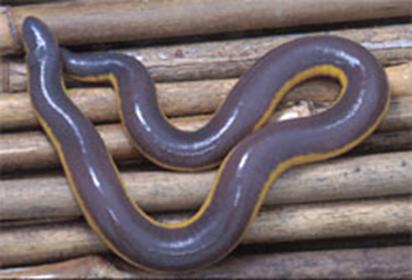


|
Gymnophiona (Apoda):
The Caecilians are an order (Gymnophiona or Apoda) of amphibians that resemble earthworms or snakes. They mostly live hidden in the ground which makes them the least explored order of amphibians, and widely unknown.
Anatomy:
Caecilians have degenerate feet, making the smaller species resemble worms, while the larger species with lengths up to 1.5 m resemble snakes. The tail is short and the cloaca is near the end of the body. Their skin is smooth and usually dark-matte, but some species have colorful skins. Inside the skin are calcite scales, which suggests that they are related to the fossil Stegocephalia. However the scales are now believed to be a secondary development, and not directly inherited from Stegocephalia. Due to their underground life the eyes are small and covered by skin for protection, which have led to the misconception that they are blind. However due to the skin cover their visual sense is limited to simple dark-light perception. All Caecilians share two tentacles at their head, which are probably used for a second olfactory capability in addition to the normal sense of smell based in the nose. Except for one lungless species - Atretochoana eiselti, only known from a single specimen collected somewhere in South America - all Caecilians have lungs, but also use the skin or the mouth for oxygen absorption. Often the left lung is much smaller than the right one, an adaptation to body shape that is also found in snakes.
Distribution:
Caecilians are found in most of the tropical regions of South-East Asia, Africa, the Seychelles islands and South America, except the dry areas and high mountains. In South America their distribution extends well into the temperate north of Argentina. They can be seen as far south as Buenos Aires, when they are carried by the flood waters of the Parana river coming from farther north. No studies have been made in central Africa, but it is likely that caecilians are found in the tropical rainforests there. The northernmost distribution is of the species Ichthyophis sikkimensis of Northern India. In Africa caecilians are found from Guinea Bissau (Geotrypetes) until Northern Zambia (Scolecomorphus). In South-East Asia the Wallace-Line is not crossed and they are not found in Australia or the islands in between. Ichthyophis is also found in South China and North-Vietnam.
Reproduction:
Caecilians are the only order of amphibians which only use internal insemination. The male Caecilians have a penis-like organ, the phallodeum, which is inserted into the cloaca of the female for 2 to 3 hours. About 25% of the species are oviparous (egg-laying); the eggs are guarded by the female. For some species the young caecilians are already metamorphosed when they hatch, other hatch as larvae. The larvae are not fully aquatic, but spend the daytime in the soil near the water. 75% of the species are viviparous, meaning that they give birth to already developed offspring. The fetus is fed inside the female with special cells of the oviduct, which are eaten by the fetus with special scraping teeth. The egg laying species Boulengerula taitanus feeds its young by developing a special outer layer of skin, which the young peel off with similar teeth. Ichthyophis is oviparous and is also known to show maternal care.
Origin of the name:
The name Caecilian derives from the Latin word caecus = blind, referring to the small or sometimes non-existing eyes. The name dates back to the taxonomic name of the first species described by Carolus Linnaeus, which he gave the name Caecilia tentaculata. The taxonomic name of the order derives from the Greek words γυμνος (gymnos, naked) and οφις (ophis, snake), as the caecilians were originally thought to be related to snakes.
Taxonomy:
Taxonomically the caecilians are divided into 5 families. The species numbers are approximate and many of these species are identified on the basis of only one specimen. It is likely that not all species have been described yet, and that some of the species described below as different may be combined into one species in future reclassifications. Beaked Caecilians (Rhinatrematidae) - 2 genera, 9 species Fish Caecilians (Ichthyophiidae) - 2 genera, 39 species Indian Caecilians (Uraeotyphlidae) - 1 genus, 5 species Tropical Caecilians (Scolecomorphidae) - 2 genera, 6 species Aquatic Caecilians (Typhlonectidae) - 5 genera, 13 species Common Caecilians (Caeciliidae) - 26 genera, 99 species
Recent discoveries:
A Swiss researcher Daniel Hofer has recently found that certain caecilians produce potent skin poisons from specialized poison glands. The poison prevents predation and the poison of the bright yellow caecilian of São Tomé Island (Schistometopum thomense) in West Africa kills other animals kept in the same tank within a few days. The chemical contents of caecilian poison have not been well studied. Werner Himstedt has shown that the skin glands of Ichthyophis protects the eggs from germs and fungi. It has also been shown that these poisons are very different from those from other amphibians such as the arrow poison frogs. The hatchlings of certain East African oviparous species of caecilians have special teeth that allow them to peel and eat their mother's skin. The mother's skin in these species was found to be thicker than normal and contained a high level of fat and other nutrients. In addition to the skin, the newborns eat the rest of their mother's body as well. |
